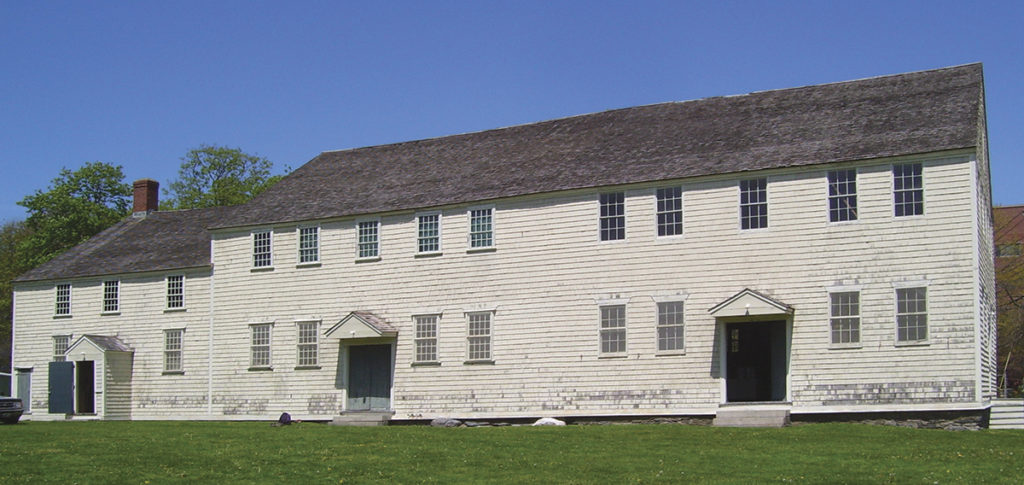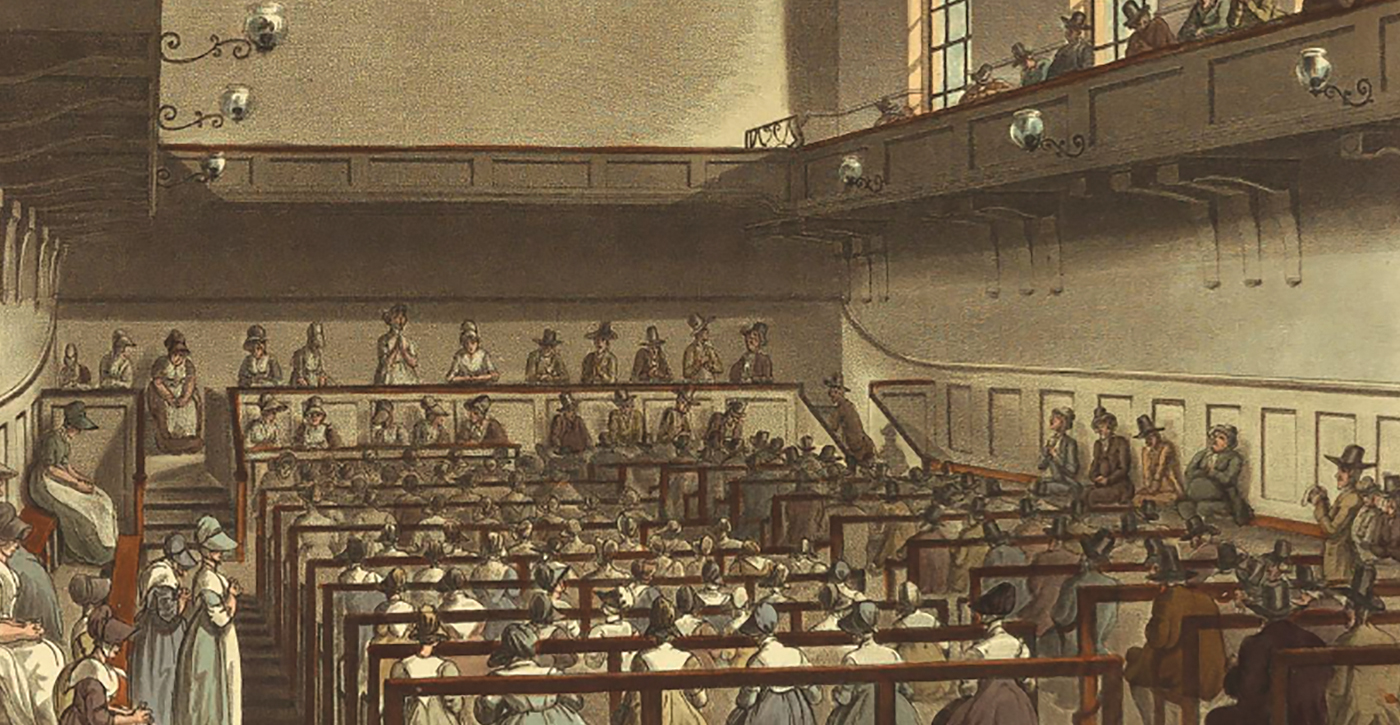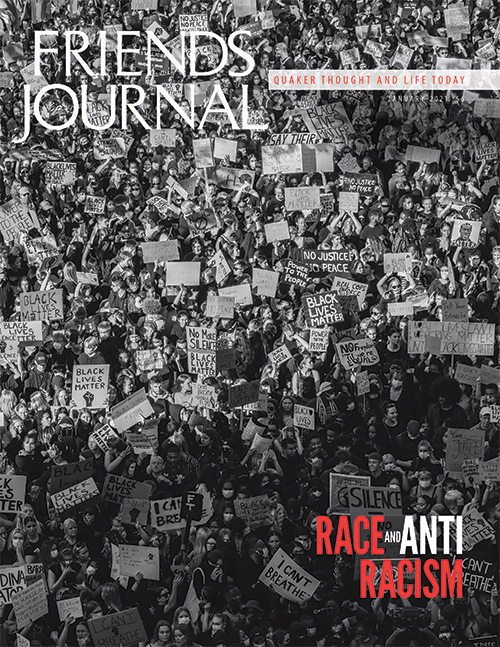In the late summer of 1768, Quakers in the Narragansett region of southern Rhode Island held a large general meeting. It was not the sessions of New England Yearly Meeting, which had taken place weeks earlier in Newport, but rather one, as they later described it, “set up and intended for the worship of Almighty God, the Promulgation of the everlasting Gospel, Comfort and edification of the brethren, the Perfecting of the Saints, &c.” The meeting, however, was disrupted by rowdy crowds outside. At the next monthly meeting, the men’s meeting resolved “to find out and prosecute such measures as may remove said grievances.” In other words, Friends appealed to civil authorities to punish those they saw as wrongdoers and to prevent a recurrence. But the town declined to intervene because the activities Friends found offensive were in public space and not unlawful. Still determined, Rhode Island Quarterly Meeting then named a committee to petition the colony’s General Assembly to change the law specifically to protect the tranquility of Quaker gatherings.
Both the meeting minutes and the petition make clear that the people whose behavior so offended Friends were “Blacks and Tawnies.” The term “Tawnies,” derived from a medieval term for tanning leather (hence a brownish color), was used commonly by Friends from the mid-seventeenth century on, including in some of George Fox’s epistles. It sometimes seems to refer to Indigenous residents of the Americas (and in other contexts, people from North African or the Indian subcontinent). In southern Rhode Island, it likely included both Indigenous Narragansetts and mixed-race individuals.
In the minutes and the petition, Friends complained that their gatherings had been “much interrupted and disquieted” in recent years by “great numbers of blacks, Tawnies & others” gathering nearby, with “little regard to the solemnity of the occasion.” Some of them sold cakes, beer, and “even Spirituous Liquors” (probably rum), “by means of which liquors some are drunken &c.” The disruptive activities also included playing Quoits (a game like horseshoes), racing horses, and “licentious Practices.” Even worse, some Friends’ children and others “not sufficiently fortified against the allurements” of these vices were apparently drawn into joining the revelry, “to the great Grief of truly Religious Parents, Guardians, &c.” If these “wicked Practices and unbecoming Divertisements” were not suppressed, Friends maintained, the dire result would be “the great dishonour of the Christian Religion [and] disregard of Government and Magistracy,” “the Extirpation of the remains of Virtue & abolition of Peaceable Government.”

This incident reveals tensions within the Quaker community (especially between younger and older Friends), as well as between Quaker mores and the behavior of their neighbors, especially People of Color. Those conflicts intensified in the 1760s, as Quaker ministers such as John Woolman urged tighter adherence to the Quaker discipline and to what were identified as Quaker standards of decorum and proper behavior. Those standards bear a striking resemblance to what have been identified as “White” and specifically English norms. In this petition, Quakers asserted that their form of “solemn” worship was not only their own chosen form but was the form consistent with virtue and true religion, and with the requirements of peaceable civil government. Friends were thus quite willing to invoke the power of the magistrate to coerce non-Quaker People of Color to behave in what Quakers thought were “proper” ways, even in public spaces.
Rhode Island Quakers maintained a close relationship with the colonial government, although not holding as many seats in the assembly as they had earlier in the 1700s. The Colony Houses in both Newport and Providence each stood within a block of the respective Friends meetinghouse. The yearly meeting clerk from 1729 to near his death in 1761 was also general treasurer of the colony. In 1768–69, Quaker Stephen Hopkins served as governor, having held that position for most of the period since 1755. (He would forfeit his membership—but not his governorship—in the 1770s for failing to manumit some of the Black people he held in slavery.) In contrast to the famous 1755 resignations from the Pennsylvania Assembly, Rhode Island’s Quaker officials saw little conflict between their Quaker commitment and serving in government through the colonial wars. So a committee of prominent Friends could expect that their petition would be favorably received by legislators who were their friends, cousins, business associates, and in some cases members of their meetings. The “rowdy disorderly Blacks and tawnies” whose behavior had troubled Friends peace did not, by contrast, have either a voice or friends in the assembly, or any way to defend their choices of ways to socialize in public space.
The assembly enacted the requested legislation specifically to protect “the General Meeting of the People called Quakers,” clarifying that it was not intended to restrict licensed tavern owners or people who sell refreshments in their own houses. In other words, it was aimed solely at street vendors and informal sales. The law provided for fines to be levied against offenders or, if they were enslaved, against their owners, and the person informing the authorities of violations was to receive half of the fines collected. Quakers could now invoke the power of the police to maintain their desired standards of tranquility and decorum, and would stand to receive half of the fines levied on those now deemed to be criminals. The legislation apparently was effective in deterring disruptions, for the following summer the monthly meeting noted that it “saw no such disorderly conduct” around the general meeting, thanks to the new law.
This incident also shows the problematic limits of Quaker concerns about slavery. It took place during the decade when Friends in New England and elsewhere had officially outlawed slave trading but not slaveholding. Power shifts within Philadelphia Yearly Meeting (PYM) had enabled antislavery reformers, including John Woolman and Anthony Benezet, to gain a major voice. In 1754, John Woolman’s “Considerations on the Keeping of Negroes” was finally approved for publication, and PYM sent out an epistle calling for an end to slave trading. Reform-minded allies in London Yearly Meeting (LYM) urged that body to also adopt a firmer policy against participation in the slave trade, and in 1758 LYM sent an epistle strongly advising all meetings to do so. New England Yearly Meeting adopted that epistle as its own policy in 1760, with John Woolman present and advocating for it. At least one Newport, Rhode Island merchant was disciplined that summer for carrying out slaving voyages, and especially (as Woolman noted in his journal) for advertising enslaved Africans for sale during yearly meeting sessions. But holding people as slaves remained acceptable, if increasingly disfavored. Many Friends chose to manumit, although it seems that in many cases the change was a formality that eased the Quakers’ tender consciences but did not significantly change the living conditions of the formerly enslaved Africans.
As historian Joanne Pope Melish has pointed out, many Quakers and other elite Whites who favored manumitting slaves did not envision a role for free Black people that incorporated them fully into the society of free citizens, with equal economic rights, voting rights, and freedom of movement. As the number of free People of Color increased in the northern colonies through voluntary manumissions and later through “gradual emancipation” laws, laws and practices (Melish argues) that had differentiated people based on unfree status were reworked to differentiate based purely on racial categories. Curfews; pass requirements; and prohibitions on loitering, for example, that had restricted movement of enslaved people, now applied to all People of Color regardless of whether they were free, indentured, or enslaved. Some have termed this “the first Jim Crow,” a foreshadowing of practices in the Southern states following Reconstruction. At least in New England, there is little evidence that Friends objected to this trend or opposed it when they were in a position to do so. Indeed, the 1768-69 incident provides evidence that many Friends shared the essentially racialized or racist vision of their non-Quaker neighbors, in which Black and Indigenous people, even when freed from hereditary legal enslavement, were restricted to subordinate roles and subjected to rules of behavior that did not apply to White community members.
Many Quakers and other elite Whites who favored manumitting slaves did not envision a role for free Black people that incorporated them fully into the society of free citizens, with equal economic rights, voting rights, and freedom of movement.
These restrictions also echo backward to much earlier ordinances restricting the public movements of Indigenous people in the region. In 1640, for example, the English settlers of Portsmouth, Rhode Island—many of whom would become Quaker after 1656—executed a compact with the Narragansett sachems who controlled the area. It defined and circumscribed limited Indian rights to hunt, fish, and kindle fires on what the English now considered their land. More problematically, it defined as punishable crimes Indians being “unruly,” or who “will not depart our houses when they are bidden,” or who were “idling about” near English houses when they did not have any trading or commerce to transact there. In other words, it criminalized living—being present—while Indian. The town records include many cases where Indigenous people were fined or even bound out as indentured workers for violating these and similar restrictions.
These compacts and their enforcement by colonial governments constitute what has been termed “racial territoriality,” using racial categories to define who has the right (or privilege) to occupy particular spaces. They turned common or shared space into racially exclusive territory, in which one group—the dominant White settler-colonists—had the power to define the roles and rules within which People of Color were allowed to be present. Infractions would be judged by White officials, using White systems of trials and punishments. Native and Black people were the subjects of these enactments but had little if any say in making or implementing the rules. It is not difficult to see threads stretching from these initial decades of settler colonialism through the periods of racial slavery and Jim Crow to the present day.
These compacts and their enforcement constitute what has been termed “racial territoriality,” using racial categories to define who has the right to occupy particular spaces. They turned common or shared space into racially exclusive territory, in which one group—the dominant White settler-colonists—had the power to define the roles and rules within which People of Color were allowed to be present.
Over the past several years, social media has provided numerous examples of incidents in which White bystanders (sometimes labeled as “Karens”) called police to complain about the supposedly threatening behavior of Black and Brown people, many of whom turn out to be engaging in unremarkable activities of daily life. The complaints have included jogging, shopping, eating lunch in a park or a student dorm, unlocking the door of one’s own house, chatting with a friend at a Starbucks café, holding a barbecue in a park, bird watching in Central Park, and campaigning for public office. As in the 1640s, common and shared spaces are claimed as racialized territory in which Black and Brown people are unwelcome, unless they are obviously fulfilling subordinate and menial service roles. Many Quakers, horrified by those incidents, have gone through antiracism training that includes how bystanders can intervene as allies to individuals who are being harassed.
In the 1768 incident, however, it was Quakers, acting officially on behalf of the meeting, who did the equivalent of those 911 calls. When told that the behavior that bothered them was not illegal, they then used their proximity and access to governmental power to change the laws to specifically make it illegal. In doing so, the meeting extended its control of territory beyond the meetinghouse itself into the surrounding area, but only when the people occupying and using that territory in ways that Friends found disturbing were Black, Indigenous, or mixed race. As their forebears had in the 1640s, these Friends used their privilege to help construct a legal and social framework that criminalized Black and Indigenous existence and behavior, and kept free People of Color in a precarious and subordinate status, always at the mercy of White policing. The work of undoing those structures, which many White Quakers want to help with, needs to include acknowledging and repenting the ways in which our own tradition has contributed to the problem.




Excellent Confession…….of Truth in History, sadly, long overdue and grievous in its indictments of settler colonists ruthless suppression of Indigenous and other peoples noble skin colors.
Regardless of the importance of their contributions, each great thinker is also “a child of their times.” Thus the great Isaac Newton wrote more pages about the prophesies in the Old Testament than about science; Martin Luther had outspoken and vindictive anti-Semitic views; the definition of “all men” (are created equal . . .) used by our founding fathers in fact excluded many men (slaves, other people of color, illiterates, not to mention women); Gospel authors did not see fit to mention any specific teachings of Jesus about marriage and parenting. A very forward-thinking person in one area may be quite backward in another. Our duty is to sift the wheat from the chaff and forgive the latter while honoring the former.
As with individuals, so with communities. We are raised within a specific culture because we are a social species; it is the air that we breathe; it is the background scenery against which we play out our lives. So we need the “prophetic voice” in every age to help us even notice that certain features of our social background are flawed and subject to change by our own activity.
Quakers have always held up the importance of Community. They also hold up Continuing Revelation, that God is not done speaking to God’s people. They are rightfully honored for trying to listen to the other, as a possible bearer of God’s word for us in the current situation. And, being a human community, of course they will not get everything right, and may fail to act on that which they know is right. It is good to acknowledge our own history and take our place among other individuals and communities who sometimes get it right but often do not. And Quakers try to listen for the so-called prophetic voice, because parts of Scriptures are also “of their times.” James Russell Lowell said it well: “New occasions teach new duties, time makes ancient good uncouth; They must upward still and onward who would keep abreast of Truth.” Perhaps our duty is to honor what Quakers have done wellS and wake them up to what they did not do well, so we may work together in bringing God’s kingdom to fruition.
Thank you so much for sharing this reflection.
Although this Rhode Island incident was indeed racialized and is consistent with a long and ignoble history of Quaker misconduct around free and enslaved people of color, I’ll note that 18c Philadelphia Quakers were likewise irked by European immigrant working class mummers, shooters, and rowdies disturbing the peace between Christmas and New Year’s; Philadelphia went so far as to ban masquerading for several decades in the early 19c. The Mummers Museum opens a window into the conflicts Quakers faced in trying to actually govern a city full of people who had no interest in “’solemn’ worship as the form consistent with virtue and true religion, and with the requirements of peaceable civil government.”